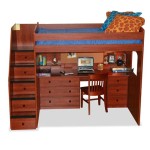Can a Nightstand Be Higher Than a Bed?
In the realm of interior design, the placement and height of furniture play a crucial role in creating a harmonious and visually pleasing space. While most would instinctively assume that a nightstand should be lower than the bed, the question of whether a nightstand can be higher than a bed is a subject that often sparks curiosity and debate. There is no definitive answer, as the decision ultimately hinges on a combination of factors, including personal preference, room dimensions, and the style of furniture involved.
Aesthetic Considerations
From a purely aesthetic standpoint, the height of a nightstand relative to the bed can significantly impact the overall visual balance and flow of the room. A nightstand that is significantly taller than the bed may create an awkward and disproportioned appearance, disrupting the visual harmony of the space. The taller nightstand can also potentially overwhelm the bed, making it appear smaller and less prominent. This disharmony can be particularly noticeable in smaller bedrooms where proportions are more critical.
However, a taller nightstand can also contribute to a visually striking and unconventional design. The contrasting heights can add dynamic tension and visual interest to the space, creating a more modern and eclectic feel. In certain design styles, such as contemporary or minimalist, a taller nightstand may complement the overall aesthetic, adding a bold and statement-making element. Ultimately, the decision boils down to personal preference and the desired aesthetic of the room.
Functionality and Practicality
Beyond aesthetics, the functionality and practicality of the nightstand also play a vital role in determining its ideal height. A nightstand that is too high can make it difficult to reach items placed on its surface, especially for individuals of shorter stature. Additionally, a high nightstand can obstruct the view from the bed, creating a sense of claustrophobia and limiting the feeling of openness in the room. This can be particularly problematic in smaller bedrooms where maximizing visual space is crucial.
On the other hand, a taller nightstand can offer several advantages. It can provide additional storage space, especially for larger items that may not fit on a standard-height nightstand. A higher nightstand can also serve as a convenient platform for displaying decorative items, creating a more visually engaging focal point beside the bed.
Room Dimensions and Furniture Style
The size and shape of the bedroom and the style of furniture involved should also be considered when deciding on the height of a nightstand. In larger rooms, the height difference between the nightstand and bed may be less noticeable and potentially even desirable. Additionally, the overall style of the room and the furniture pieces can influence the appropriateness of a taller nightstand. A modern and contemporary bedroom might welcome a taller nightstand, while a traditional bedroom might prefer a lower option that maintains the classic aesthetic.
Furthermore, the specific design of the bed itself can play a role in determining the ideal height of the nightstand. Beds with high headboards may require a taller nightstand to create a visually balanced and cohesive appearance. In contrast, beds with low headboards may be better suited to a lower nightstand. Ultimately, the ideal height of a nightstand should be chosen in conjunction with the overall dimensions, style, and aesthetic of the room.

Should Bedside Table Be Higher Or Lower Than Bed Provincial Home Living

Should Bedside Table Be Higher Or Lower Than Bed Provincial Home Living

Should Nightstands Be Taller Than The Bed

Our Ultimate Guide To Bedside Table Sizes
How Tall Should Your Nightstand Be Designed

Should Bedside Tables Be Higher Than Bed Chelsea Furniture

How To Match A Bed And Bedside Tables Top 10 Design Tricks

Master Bedroom Progress Thelotteryhouse

The Ultimate Guide For Choosing Right Nightstands

Our Ultimate Guide To Bedside Table Sizes







